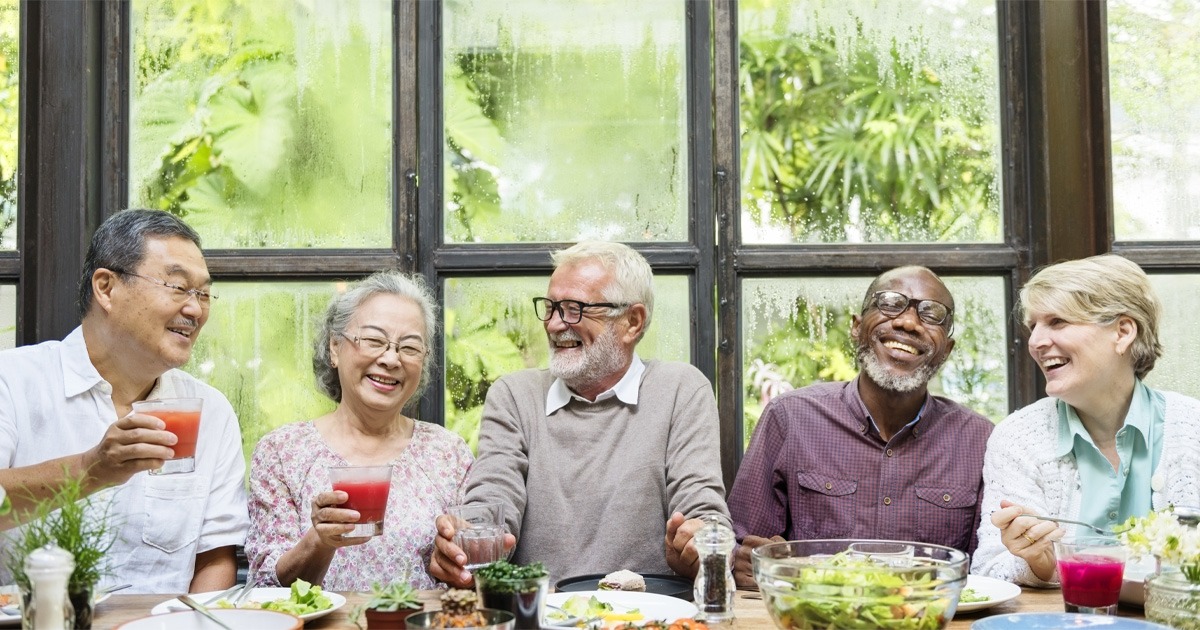Last updated on June 15th, 2023
As of 2020, the Administration for Community Living (ACL) reported that older adults (people who are 65+ years old) made up 17% of the population. By 2040, that number will increase to 22% – around 4x higher than numbers seen at the turn of the 20th century. The senior population is only growing and diversifying more with each year. Because of that, senior living communities must be ready to accommodate the needs of a larger, more diverse variety of seniors.
Concepts like diversity, equity, and inclusion (DEI) are likely already a part of your vocabulary as a senior living staff leader. However, true DEI measures are more than simply acknowledging diversity. Whether it’s celebrating multicultural holidays or hiring staff that is culturally representative of your residents, thoughtfully and intentionally weaving DEI into your community is imperative to create a welcoming environment for everyone.
One way to do this is through food. Your dining program can and should be representative of the diverse cultures and, therefore, taste palettes in your community. Doing this is easier than ever with the wealth of culinary resources available today, including the ones that come with our food management services.
The Importance of Inclusivity and Getting Your Residents’ Thoughts
Part of making a change is determining why inclusivity is important for your residents. Who are they, and where do they come from? What are the different religious, ethnic, and racial and groups in your senior community? Surveying your residents is one way to get answers to these questions but sitting down and conversing with them is even more meaningful. Here are some tips on how to collect the DEI information you need and measure resident satisfaction:
- Implement regular “town hall” meetings for residents to express their thoughts and ideas openly with staff.
- Have an anonymous way for residents to submit feedback about dining changes, future meals they’d like to see on the menu, or any other part of your culinary program.
- Listen to residents’ perspectives and take actionable steps to address provided feedback.
Not only will initiating a conversation about diversity among residents help them feel more valued and respected, but it also promotes self-determination. A higher degree of self-determination is associated with a better quality of life, indicating the importance of providing seniors with a choice – and making changes based on those choices.
How to Create Culturally Diverse Menus
After you’ve gathered residents’ culinary opinions and preferences, it’s time to start creating your culturally diverse menu.
Taking a Biopsychosocial Approach
Some research shows that taking a biopsychosocial approach to plan culinary programs helps increase engagement and excitement about mealtime for seniors, especially for those with cognitive impairments like dementia or Alzheimer’s disease.
A biopsychosocial assessment includes looking at a person’s culture, how it impacts their well-being, and any health disparities they might experience related to it. For many older adults, their last living environment can provide clues to help you determine the best culinary approach. Staff dietitians can conduct these assessments, work with other food service staff to implement changes based on their findings, and ensure that all safety and nutrition standards are being followed.
Researching Foods and Holidays
Researching foods from different cultures is another step in creating a culturally diverse menu. You can show residents that you’re invested in learning about their culture by exploring and developing a strong understanding of different cuisines, including their flavors, traditions, and requirements. Holidays, including holy days, are also a part of being fluent in a culture. For example, it’s crucial to have kosher and halal options for Jewish and Muslim residents outside of religious holidays. You might also include dishes like Indian curries with naan bread, Mexican tacos filled with a choice of meats and fresh toppings, Italian pasta dishes such as lasagna or spaghetti carbonara, Chinese stir-fries with vibrant vegetables, or traditional Japanese sushi rolls and miso soup.
SNAP4CT has a great guide on multicultural foods from the five food groups. So, even if a specific cultural dish isn’t on the menu, you can still incorporate a variety of options from around the world.
Challenges to Creating Culinary Diversity
Creating a culturally diverse menu may present staff with unexpected challenges, requiring extra coordination and effort. Here are some obstacles to be aware of:
- Varying dietary restrictions of residents. Some individuals may have specific nutritional needs due to health conditions or religious practices, so it’s important to note these when the resident moves in.
- Finding reliable sources for authentic ingredients. Sourcing proper ingredients can be a hurdle, especially if they aren’t commonly found locally. Ordering online and partnering with small, traditional businesses (and a good food service management partner) can help overcome this challenge.
- Offering a wide range of culinary dishes. It can be challenging to accommodate everyone in a senior community with a large diversity. Remaining cost-effective and culturally conscious takes careful planning and frequent communication with residents and their families.
One nuanced consideration is that starting a conversation about culture might be difficult for some residents because many may have experienced discrimination or shame related to the foods they eat. For example, this food-shaming and bullying, or “othering,” is something many younger Asian Americans are shedding light on. Even though the younger generations are raising awareness about how this has impacted their connection to their culture and overall ethnic identity, older generations – especially those in the Baby Boomer generation – have also dealt with similar challenges during their lifetime. Building trust with your residents is key to making them feel safe and vulnerable to open up about their culture.
However, it’s important to remember that you don’t always have to have all the answers. You aren’t expected to know everything about every culture in the world, but you can invest your time in learning as much as you can about the ones your residents identify with. Assistance can make things a bit easier, helping you create a more inclusive environment without stress.
Dining Program Assistance You Can Trust
In addition to the mentioned recommendations for creating a culturally diverse menu, partnering with a food management service that specializes in working with diverse senior communities is extremely helpful. At Culinary Services Group, diversity is a large part of our philosophy.








